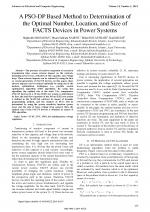| 1/2014 - 17 |
A PSO-DP Based Method to Determination of the Optimal Number, Location, and Size of FACTS Devices in Power SystemsSHOJAEIAN, S. |
| Extra paper information in |
| Click to see author's profile in |
| Download PDF |
Author keywords
TCSC, SVC, PSO, loss minimization, voltage regulation
References keywords
power(9), systems(8), swarm(4), optimization(4), optimal(4)
Blue keywords are present in both the references section and the paper title.
About this article
Date of Publication: 2014-02-28
Volume 14, Issue 1, Year 2014, On page(s): 109 - 114
ISSN: 1582-7445, e-ISSN: 1844-7600
Digital Object Identifier: 10.4316/AECE.2014.01017
Web of Science Accession Number: 000332062300017
SCOPUS ID: 84894631897
Abstract
The presence of reactive component of current in transmission lines causes adverse impact on the network, including power losses, reduction of line capacity, and voltage drop. These adverse impacts can be reduced by using the first or second generation of FACTS devices. In this paper, these adverse impacts can be reduced optimally by using one of the modern optimization techniques, i.e., particle swarm optimization algorithm (PSO algorithm). By using this algorithm, the optimal size of the static VAr compensator (FACTS devices) in a 30 bus IEEE test system is determined. At first, the load flow equations of the 30 bus IEEE test system is defined in the MATLAB software by means of dynamic programming method, and the number of SVCs will be determined by using the system sensitivity function (power losses and the sum of buses voltage drop square); then, the optimal sizes of the FACTS devices is obtained by means of PSO algorithm. |
| References | | | Cited By |
Web of Science® Times Cited: 8 [View]
View record in Web of Science® [View]
View Related Records® [View]
Updated today
SCOPUS® Times Cited: 9
View record in SCOPUS® [Free preview]
View citations in SCOPUS® [Free preview]
[1] Optimal design of fuzzy-AGC based on PSO & RCGA to improve dynamic stability of interconnected multi area power systems, Falehi, Ali Darvish, International Journal of Automation and Computing, ISSN 1476-8186, Issue 4, Volume 17, 2020.
Digital Object Identifier: 10.1007/s11633-017-1064-0 [CrossRef]
[2] Optimizing SVC placement for enhanced voltage stability using a novel index and hybrid ABC-PSO algorithm, Rahman, Hafizur, Mia, Roman, Rahman, Mustafizur, Limon, Md. Faiyaj Ahmed, Iqbal, Md. Shahid, Jubayer, Md. Fahad, Karim, Md. Rabiul, Soeb, Md. Janibul Alam, Franklin Open, ISSN 2773-1863, Issue , 2025.
Digital Object Identifier: 10.1016/j.fraope.2025.100299 [CrossRef]
[3] Determining Optimal SVC Location for Voltage Stability Using Multi-Criteria Decision Making Based Solution: Analytic Hierarchy Process (AHP) Approach, Aydin, Faruk, Gumus, Bilal, IEEE Access, ISSN 2169-3536, Issue , 2021.
Digital Object Identifier: 10.1109/ACCESS.2021.3121196 [CrossRef]
[4] An Optimization Algorithm of Overseas Surgical Warehouse Location of Cross-Border Medical Supply Chain Network Based on Parallel Big Data Mining, Ma, Zhijun, Journal of Testing and Evaluation, ISSN 0090-3973, Issue 1, Volume 51, 2023.
Digital Object Identifier: 10.1520/JTE20210449 [CrossRef]
[5] An energy‐aware method for data replication in the cloud environments using a Tabu search and particle swarm optimization algorithm, Ebadi, Yalda, Jafari Navimipour, Nima, Concurrency and Computation: Practice and Experience, ISSN 1532-0626, Issue 1, Volume 31, 2019.
Digital Object Identifier: 10.1002/cpe.4757 [CrossRef]
[6] A Fuzzy Based Evolutionary Algorithm for Solving Multiobjective Optimal Power Flow with FACTS Devices, Vanitha, R., Baskaran, J., Mathematical Problems in Engineering, ISSN 1024-123X, Issue , 2015.
Digital Object Identifier: 10.1155/2015/275129 [CrossRef]
[7] A Multi-objective PMU Placement Method Considering Observability and Measurement Redundancy using ABC Algorithm, KULANTHAISAMY, A., VAIRAMANI, R., KARUNAMURTHI, N. K., KOODALSAMY, C., Advances in Electrical and Computer Engineering, ISSN 1582-7445, Issue 2, Volume 14, 2014.
Digital Object Identifier: 10.4316/AECE.2014.02020 [CrossRef] [Full text]
Disclaimer: All information displayed above was retrieved by using remote connections to respective databases. For the best user experience, we update all data by using background processes, and use caches in order to reduce the load on the servers we retrieve the information from. As we have no control on the availability of the database servers and sometimes the Internet connectivity may be affected, we do not guarantee the information is correct or complete. For the most accurate data, please always consult the database sites directly. Some external links require authentication or an institutional subscription.
Web of Science® is a registered trademark of Clarivate Analytics, Scopus® is a registered trademark of Elsevier B.V., other product names, company names, brand names, trademarks and logos are the property of their respective owners.
Faculty of Electrical Engineering and Computer Science
Stefan cel Mare University of Suceava, Romania
All rights reserved: Advances in Electrical and Computer Engineering is a registered trademark of the Stefan cel Mare University of Suceava. No part of this publication may be reproduced, stored in a retrieval system, photocopied, recorded or archived, without the written permission from the Editor. When authors submit their papers for publication, they agree that the copyright for their article be transferred to the Faculty of Electrical Engineering and Computer Science, Stefan cel Mare University of Suceava, Romania, if and only if the articles are accepted for publication. The copyright covers the exclusive rights to reproduce and distribute the article, including reprints and translations.
Permission for other use: The copyright owner's consent does not extend to copying for general distribution, for promotion, for creating new works, or for resale. Specific written permission must be obtained from the Editor for such copying. Direct linking to files hosted on this website is strictly prohibited.
Disclaimer: Whilst every effort is made by the publishers and editorial board to see that no inaccurate or misleading data, opinions or statements appear in this journal, they wish to make it clear that all information and opinions formulated in the articles, as well as linguistic accuracy, are the sole responsibility of the author.



